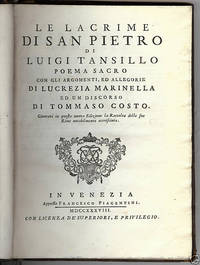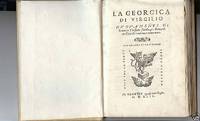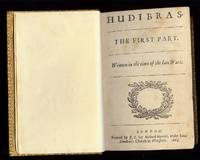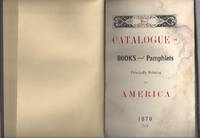
Le Lacrime di San Pietro di Luigi Tansillo Poema Sacro con Gli Argomenti, ed Allegorie Di Lucrezia Marinella ed Un Discorso Di Tommaso Costo. Giuntavi in Questa nuova Edizione la Raccolta delle sue Rime notabilmente accredsciuta. First Edition, 1738
by Tansillio, Luigi
- Used
- Hardcover
- first
- Condition
- See description
- Seller
-
Swampscott, Massachusetts, United States
Payment Methods Accepted
About This Item
Extremely Rare Book Publication! The only library that has a copy of this book is the: Bayerishe Staatsbibliothek. Le Lacrime di San Pietro di Luigi Tansillo Poema Sacro con Gli Argomenti, ed Allegorie Di Lucrezia Marinella ed Un Discorso Di Tommaso Costo. Giuntavi in Questa nuova Edizione la Raccolta delle sue Rime notabilmente accredsciuta. In Venezia Appresso Francesco Piagentini. MDCCXXXVIII (1738). ConLicenza De Superiori, E Privilegio.
In Venice: Francisco Piacentini 1738, 1738. 3 parts in a volume in-4° (255x185mm), pp. (1), XXIV, 160, XXXII, 83, Nice mottled calf leather binding with gold filigree in bands on the spine. Original multi-colored internal boards with edging blue swirls decorate with an arabesque style. Text on two columns of the ten songs of the "Tears of Saint Peter" similar to the compositions of a religious character of the same Cost ("spiritual Rhymes over the effusion of the blood of Our Gentleman", "Sonetti to the image of the Crocifisso"), sonetti and the songs of the Tansillo in one collection are considerably increased in this edition. The arguments and the allegorie that precede the proemiale text are of Lucrezia Marinella, transcribed here as written in her original hand. This edition appeared first in Barezzi in 1602. The edition originates them of the poema is of Vico Equense, 1585. It shapes itself as rising of along "I plant spiritual" of the apostle Peter nearly 1,300 lines uniform in 15 books. Beautiful and corrected settecentesca edition of the main Tansilliani Poetici. Brunet, V, 654. Also referenced in Brunet, 298 From the library of Le Comte F. de Gramont- A poet who is referenced in "A Sheaf Gleaned in French Fields" by Toro Dutt, 1880: London: C. Kegan Paul & Co.; Dated 1809. With a pouncing lion insignia on the spine in gilt. Some edge damage along the spine and end sewing at head of spine is nearly gone.Collation: (2-Blank); (4); tt8; A8-I8; K8.Discoros Del Signor Tommaso Costo Per lo quale si dimostra questo Poema delle Lagrime di S. Pietro del Tansillo. Essere per opra sua rimesso come dall' Autore fu lasciato scritto.Collation: A8-B8.Sonnetti e Canzoni del Signor Luigi Tansillo.Collation: a8; b7.Stanze del Signor Luigi Tansillo.Collation: b1; c8; d5 Idue Pellegrini del Signor Luigi Tansillo Collation: (1); A2; e6; f4; (2-Blank) Lucrezia Marinella Vacca /Marinelli (1571-1653) We know more about the publishing history of Lucrezia Marinella's works than we do about her life. When other women were publishing anonymously or under a pseudonym, Marinella's name was on most of her books and she was known by all Venice as the author of the rest. She apparently used the feminine form of her last name; some editors have used the family form, "Marinelli." Lucrezia was the daughter of a Venetian physician who wrote works on medicine (two on women's health) and on philosophy. We know nothing of her mother nor of when her father died do (we know that he was dead by 1600). Someone saw to it that Lucrezia was given an education that included philosophy and classical as well as vernacular literature. At some point she married a physician, Girolamo Vacca, and had at least two children, a son and daughter. When Marinella was 24 years old, her first work was published, La colomba sacra, poema eroico (The holy dove, a heroic poem), a biographical epic in ottava rima on an early Christian martyr. Her next publication was the Nobilta et l'eccellenza delle donne, co' difetti et mancamenti degli uomoni (The nobility and excellences of women, and the defects and vices of men), printed in 1600 and enlarged in 1601. Between 1603 and 1606 six more works were published (although some appear to have been written earlier): a heroic poem and a prose work on Mary; poems on Francis of Assisi and on Justina (another early Christian martyr); a collection of Marinella's sonnets and madrigals, and a pastoral verse novel, Arcadia felice. After 1606 there is a gap of 12 years before her next publications --- an allegory based on the story of Cupid and Psyche, and a poetic biography of Catherine of Siena --- and then another 11 years before she published in 1635 what historians of Italian literature consider her masterpiece, L'Enrico overo Bisantio conquistato (Henry or Byzantium gained). We don't know the connection between these gaps and her life as a wife and mother. By the 1590s, the Roman influence that we call "Baroque" had come to Venice. It grew, in part, out of the Catholic Church's need to reach out to people, to instruct and to arouse them more directly than it had done before. For literature, the result was an emphasis on vernacular writing with a strong emotional appeal. All of Marinella's writing reflects the Baroque, but in different ways and from a feminine perspective. She usually wrote in the heroic verse form, but sometimes in a combination of verse and the "poetic prose" that she saw as capable of the same elevation as poetry. Many of Marinella's books were lives of religious figures, but almost always about women and then always with the emphasis on their heroism rather than on more passive virtues. She wrote of the heroic resistance of the women Columba and Justina; her book on Catherine of Siena was on the "heroic deeds and marvelous life"; her life of Mary (apparently the most successful during her lifetime) was on Mary as "empress of the universe"; in a later edition of her early poem on Francis, Clare of Assisi's "glorious passion" receives equal billing. Her secular writing also fused the extravagance of the popular chivalric tales and heroic epics with a Christian, but feminine, view of morality. One satirically allegorizes the myth of Cupid and Psyche as a conflict between body and soul; another is a pastoral verse drama that makes fun of human love. L'Enrico overo Bisantio conquistato is an epic in the style of Torquato Tasso's La Gerusalemme liberata, but with stronger, more self-reliant women. To date, the only work of Marinella's that has been translated into English is part of her Nobilta et l'eccellenza delle donne. It differs from her other writings in being a polemical treatise, a genre in which extravagant statement and personal attack were acceptable. Forty-five years later, Marinella would write Essortationi alle donne et a gli altri (Exhortations to women and others), in which she would qualify some of the more extreme views expressed in Nobilta. But in 1600, Marinella would say whatever she needed to say in order to refute the misogynist statements of earlier writers, particularly the treatise of Giuseppe Passi, who had published Dei donneschi defetti (The defects of women) in 1599. Although it differs in purpose from her other works, Nobilta shares with them Marinella's Baroque qualities of intensity, extravagant rhetoric, and emotional appeal; it also shares their confidence in a woman's ability. In 4 Legat. in m. pergam. con tit. in oro su tassello, pp.2nn.,XXIV, 160, XXXII, 83 con una bella tavola a p.pagina all'antiporta incisa in rame da Zuliani Veneto, frontalini, finalini e capilettera figurati. Magnifico esemplare in barbe di questa rara edizione. Brunet, 298.
Reviews
(Log in or Create an Account first!)
Details
- Bookseller
- Calix Books
(US)
- Bookseller's Inventory #
- biblio19
- Title
- Le Lacrime di San Pietro di Luigi Tansillo Poema Sacro con Gli Argomenti, ed Allegorie Di Lucrezia Marinella ed Un Discorso Di Tommaso Costo. Giuntavi in Questa nuova Edizione la Raccolta delle sue Rime notabilmente accredsciuta. First Edition, 1738
- Author
- Tansillio, Luigi
- Illustrator
- Unknown
- Format/Binding
- 4to Nice binding very good condition
- Book Condition
- Used
- Jacket Condition
- none
- Quantity Available
- 1
- Edition
- From the library of Le Comte F. de Gramont- A poet who is refere
- Binding
- Hardcover
- Publisher
- Piagentini, Francesco
- Place of Publication
- Venezia (Venice)
- Date Published
- 1738
- Pages
- 160
- Size
- 4to
- Weight
- 6.00 lbs
- Keywords
- Rare Book, Rare Books, Poetry, Italian Poetry
- Bookseller catalogs
- Art and Poetry;
Terms of Sale
Calix Books
30 day return guarantee, with full refund including original shipping costs for up to 30 days after delivery if an item arrives misdescribed or damaged.
About the Seller
Calix Books
About Calix Books
Glossary
Some terminology that may be used in this description includes:
- Spine
- The outer portion of a book which covers the actual binding. The spine usually faces outward when a book is placed on a shelf....
- Gilt
- The decorative application of gold or gold coloring to a portion of a book on the spine, edges of the text block, or an inlay in...
- Calf
- Calf or calf hide is a common form of leather binding. Calf binding is naturally a light brown but there are ways to treat the...
- Acceptable
- A non-traditional book condition description that generally refers to a book in readable condition, although no standard exists...
Frequently asked questions
This Book’s Categories
Also Recommended
-

Save 10% on every purchase!
Join the Bibliophiles’ Club and start saving 10% on every book.
$29.95 / Year











